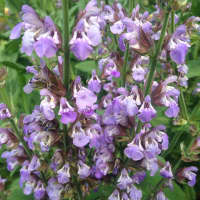Sage (Salvia officinalis L.)
Composition
The leaves contain:
- Caffeic acid
- Carnosic acid
- Carnosol
- Chlorogenic acid
- Fumaric acid
- Rosmarinic acid
- Ursolic acid
- Ursonic acid
The essential oil contains:
- Borneol
- Cineole
- Thujone
Healing Properties
Anti-Diabetic
Improves insulin sensitivity[1]
Anti-Fungal (antifungal)
Antiinflammatory
Reduces inflammation as judged by plasma cytokines.[1:1]
Prevents inflammation from high fat diet-induced obesity.
Anti-Obesity
Inhibits lipogenesis (the metabolic formation of fat).[1:2]
Antioxidant
Free radical scavenging ability.
Disease / Symptom Treatment
Neurodegenerative Diseases
Alzheimer’s Disease
Salvia officinalis extract showed a potential effect on cognitive functions and reduced the incidence of agitation among Alzheimer’s patients.[2]
Cancer
Breast Cancer
A relatively strong effect against human breast adenocarcinoma (MCF-7) was observed for the S. officinalis extract.[3]
Leukemia
Salvia officinalis extract showed remarkable cytotoxic effect toward human T-lymphoblast leukemia and adriamycin resistant leukemia.[3:1]
Diabetes
Sage presents an alternative to pharmaceuticals for the treatment of diabetes.[1:3]
Prevents insulin resistance[1:4]
